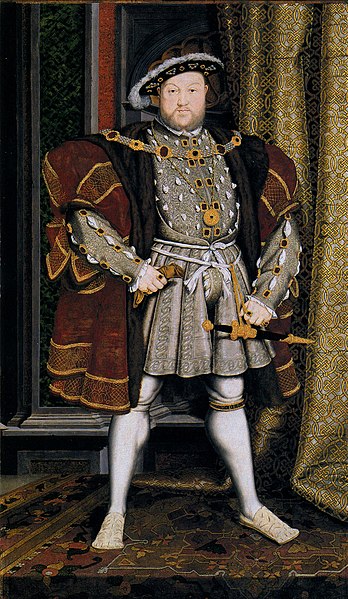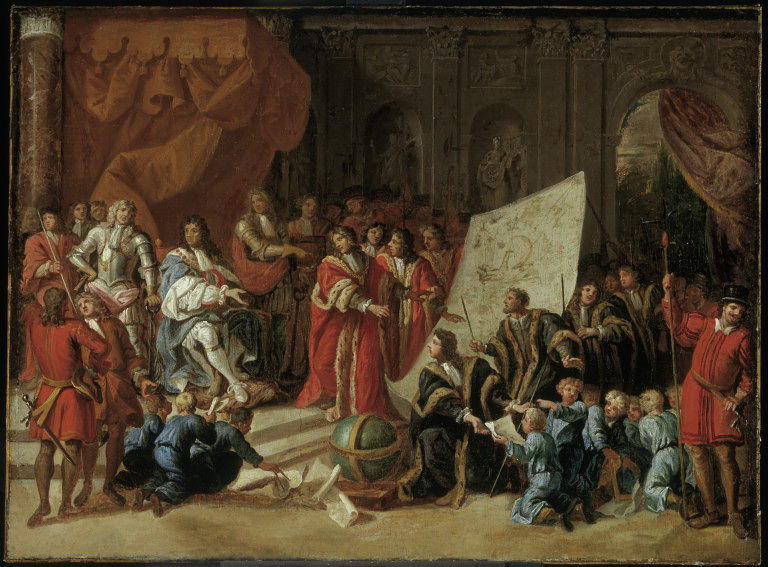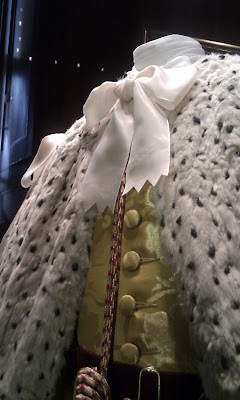I found this book really interesting and it has helped me to understand the origins of these robes. I do not know an awful lot about pre-16th century costume, very little in comparison is written about it and so I have found it great to really branch out and try and find more information. It broadens my knowledge, which I think will be beneficial in the future and it has helped me to develop my research skills. Now that I am familiar with the National Art Library I will able to use it much more easily, which will, hopefully, initially help with my dissertation in level 6.
In 1515 'all noblemen and others are to be apparelled according to their degrees and no man must presume to wear above his degree' (pg41), this shows the importance of dress showing status in the early 16th century, it would be seen to be unjust to wear certain colours and fabrics that were socially higher than oneself. This rule however was not necessarily followed. Philip Stubbes in 1583 described the fashion of London as 'there is such a confused mingle mangle of apparel in Ailgna... that it is verie hard to know who is noble, who is worshipful, who is gentleman and who is not'
This outlines some of the social positions in England at the time:
The House of Tudor - King and family
Nobility - Dukes, Earls, Marquesses and Lords
Gentry - Knights, Esquires and Gentlemen
Middling and Lower Sort - Yeoman, Husbandmen and Labourers
(Exceptions: Women, Ecclesiastical and Clergy, Entertainers, Secular professions and Urban Elite)
Social hierarchy was much debated at the time, for example, contemporary social theory suggests there were 3 social orders: the nobility, the clergy and the rest, whereas another theory suggests society is split into 2 groups, the landed rural and the urban. The landed rural consists of Dukes, Earls, Barons, Knights, Gentlemen, Yeomen, Husbandmen and Labourers and the urban are Merchants, Mastercraftsmen, Journeymen, Servants and Marginals. Mayors fit into the the urban society.
%20(250).jpg)
%20(250).jpg)
%20(250).jpg)
%20(250).jpg)
%20(250).jpg)
%20(250).jpg)
Hayward argues that society did comply to the social dress as demonstrated in Hans Holbein's series of engravings called 'Dance of Death', which shows distinctive styles of dress for social groups. Also as Holbein was a German Renaissance artist it shows that rank was demonstrated through dress throughout Europe.
It is interesting to learn of the restrictions on dress. For instance, in France only the elite were allowed to wear long gowns. Also I found this quote really interesting: ' The Henrican acts of apparel were highly gendered. They were intended to establish and reinforce the male hierarchy.. The acts concentrated on male dress because men were seen in the public sphere, they held office and they could use their clothes to assert their identity' (p.45). Female dress had no state regulation and therefore there was little concern regarding it.
I would like to learn more about this in my spare time, it would be interesting to learn how long these regulations were in place and how this affected the development of female dress as well as their place in society.

Clothing in the 16th century was highly gendered and was influential in the formation of the gender. Male dress had broad shoulders and codpieces, clearly denoting masculinity. Also the gowns became shortened for younger men, meaning their legs were now visible, helping to stress how they were physically, socially and politically more mobile. I think there is no better example of this masculine clothing than the above portrait of Henry VIII by Hans Holbein the Younger in 1537.
Interestingly the showing of legs in male fashion has continued in history. For instance in Regency fashion fashionable pigeon-chested men would often pad their calves to show strength and masculinity. I find that it is so subtle in comparison to female fashion that you hardly notice its significance or statement. Where women in history have used fashion to express themselves in a patriarchal society, men have had no need and the changes that have occurred have often been to signify their superior position in society.
The Urban Elite - Mayors!
Consisting of merchants, members of livery companies, professional men and parish clergy, the urban elite had no restrictions on dress through legislations and they were beginning to play an increasingly important role in society as became richer through trade and therefore gained political influence.
After Henry VII's victory at Bosworth in 1483 he came to London. It was decided that on his arrival the Mayor and his Aldermen should dress in scarlet in order to greet the King, accompanied by 435 citizens who wore 'bright murrey' gowns.
'Clothing of specific colours was used to create a corporate identity and to emphasize the social and political hierarchy in an urban context' In an increasingly rich new society I imagine it was now important to show the rising power if the professional men and they had more freedom to do this as they were under no clothing laws.

From the 14th century
onwards civic authorities were increasingly conscious of a need for their
officials to dress appropriately so as to represent them well. For instance
from 1377 onwards sergeants were given livery to wear (see Civic Livery page)
If you had either a professional
or mercantile background you could make a career in civic government though
this became an increasingly expensive position as their company had to pay for
gowns and so by 1540s people sought to avoid the position!
Scarlet was the usual colour for the Mayors robes but this
varied as there have been references to grey robes. Also interestingly the
White Book of London referred to summer and winter robes.
The
Maire of Bristowe in Kalendar from September 1479 depicts the induction of the
new mayor of Bristol.
The new mayor, the mayor and the aldermen are all dressed in
scarlet robes with grey fur lining. His
attendants are dressed in blue and murrey parti-livery with horizontal red
stripes. I think this is referring to the ‘visual straightjacket’ that the
serjeants had to wear as outlined in the Civic Livery page.
Rank
was linked to colour and so the Mayor wears scarlet as it is the most expensive
of the red shades as it is made from insect dyes, whereas lesser roles wore cheaper
shades made from madder
Around
1446 Aldermen of London wore a pink mantle, fastened on the right shoulder with
a checked lining as well as black coats, helping to give them a group identity
This book has been a
very valuable source of research for me. I feel I now know the context of the
mayors robe and the reasons for its use of colour. I have also really enjoyed
visiting the National Art Library and feel this has helped me to develop my
.jpg)
.jpg)
.jpg)
.jpg)
.jpg)
.jpg)
.jpg)
.jpg)
.jpg)
.jpg)
.jpg)
.jpg)

.jpg)
.jpg)
.jpg)
.jpg)
.jpg)


.jpg)

%20(250).jpg)
%20(250).jpg)
%20(250).jpg)
%20(250).jpg)
%20(250).jpg)
%20(250).jpg)

.jpg)






















